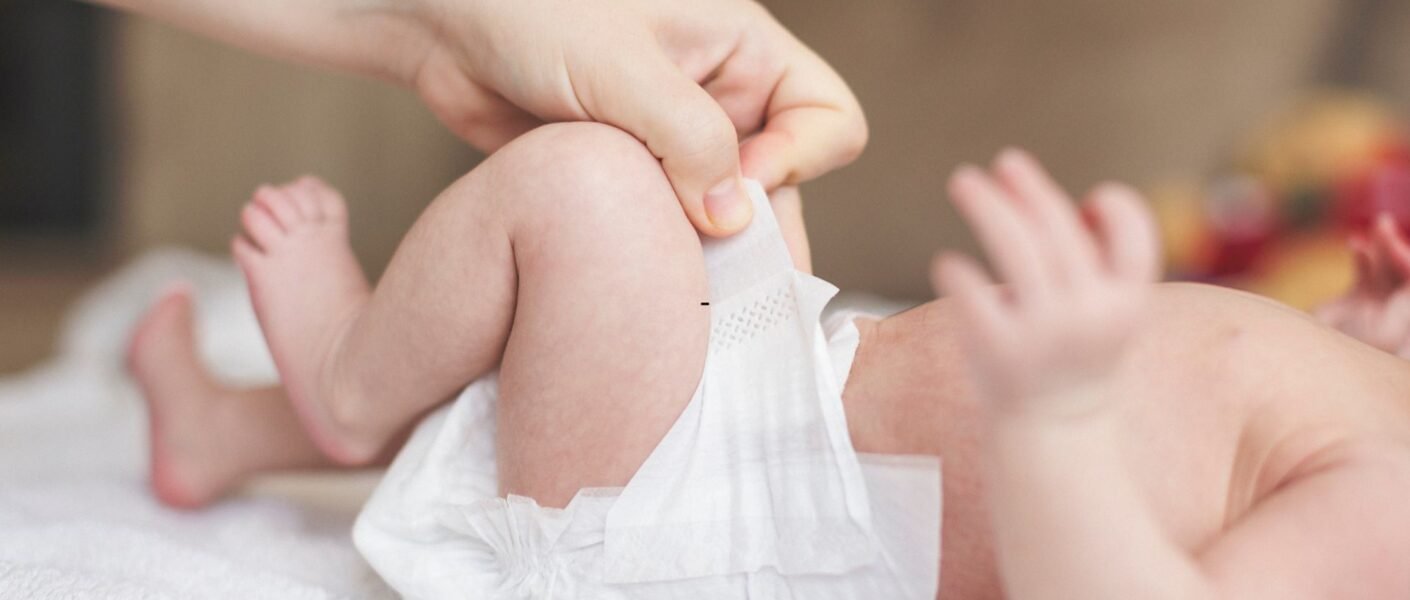A Comprehensive GuideBringing a new baby home is a joyous occasion, filled with cuddles, coos, and… a lot of diaper changes. One of the most frequent questions new parents have is: “How often should I really be changing my baby’s diaper?”
It might seem like a simple task, but keeping your baby clean and dry is crucial for their comfort and health.
This guide will walk you through everything you need to know about diaper changing frequency, addressing various factors and providing practical tips.
Why Frequent Diaper Changes Matter
Changing your baby’s diaper isn’t just about convenience; it’s essential for preventing discomfort and potential health issues. Here’s why frequent changes are so important:
- Preventing Diaper Rash: A wet or soiled diaper creates a moist environment that can irritate your baby’s delicate skin. Prolonged exposure to urine and feces can lead to diaper rash, a common skin condition characterized by redness, bumps, and irritation in the diaper area.(Mayo Clinic) Changing diapers often helps keep the area clean and dry, minimizing the risk of rash.
- Protecting Against Infections: The combination of moisture and waste in a diaper can promote the growth of bacteria and fungi. These microorganisms can cause infections, such as yeast infections (Candida) in the diaper area. Regular diaper changes help maintain hygiene and reduce the likelihood of infections.
- Ensuring Comfort: Imagine sitting in damp clothing all day – it wouldn’t be comfortable! Babies are no different. A clean, dry diaper keeps your little one feeling fresh and comfortable, which can contribute to a happier, less fussy baby.
- Promoting Skin Health: Frequent diaper changes, combined with proper cleaning and drying, help maintain the integrity of your baby’s skin barrier. This barrier protects against irritants and allergens, keeping the skin healthy and resilient.
Recommended Diaper Changing Frequency by Age
The ideal diaper changing frequency varies depending on your baby’s age and individual needs. Here’s a general guideline:
Newborns (0-2 Months)
- Frequency: Every 2-3 hours or as needed.
- Why: Newborns have small bladders and frequent bowel movements. They may urinate as often as every one hour. Changing diapers frequently during this stage is crucial for preventing skin irritation. Many sources suggest changing diapers right before every feeding, which often works out to be every 2 hours.
- Nighttime: Change diapers every 3 hours during the first few weeks, even overnight.
Infants (2-6 Months)
- Frequency: Every 3-4 hours.
- Why: As babies grow, their bladder capacity increases, and bowel movements may become less frequent. However, it’s still important to check diapers regularly and change them whenever they are wet or soiled.
Older Babies (6+ Months)
- Frequency: Every 3-4 hours, or as needed.
- Why: By this age, many babies have established more predictable bowel movement patterns. You can often adjust the diaper changing schedule based on your baby’s individual needs.
Factors That Influence Diaper Changing Frequency
While the above guidelines provide a general framework, several factors can influence how often you need to change your baby’s diaper:
- Diet: Breastfed babies tend to have more frequent bowel movements than formula-fed babies. If your baby is breastfed, you may need to change diapers more often.
- Fluid Intake: Babies who drink more fluids will naturally urinate more frequently.
- Sensitivity: Some babies have more sensitive skin than others and are more prone to diaper rash. If your baby has sensitive skin, more frequent diaper changes are essential.
- Type of Diaper: Some diapers are more absorbent than others. Highly absorbent diapers may allow you to go slightly longer between changes, but it’s still crucial to check regularly.
- Illness: During periods of illness, such as diarrhea, your baby may need more frequent diaper changes.
Signs That Your Baby Needs a Diaper Change
Don’t rely solely on a set schedule. Learn to recognize the signs that your baby needs a diaper change:
- Smell: This is the most obvious sign!
- Feeling the Diaper: Gently feel the diaper to check for wetness or fullness.
- Irritability or Fussiness: A wet or soiled diaper can make your baby uncomfortable and fussy.
- Visual Inspection: Take a peek inside the diaper to check for stool.
Tips for Effective Diaper Changing
Changing a diaper might seem straightforward, but these tips can help you do it effectively and efficiently:
- Gather Your Supplies: Before you start, have everything you need within reach: a clean diaper, wipes, diaper rash cream (if needed), and a changing pad.
- Clean the Area Thoroughly: Use gentle, fragrance-free wipes to clean your baby’s diaper area. For girls, wipe from front to back to prevent urinary tract infections.
- Dry the Skin: Pat the skin dry with a soft cloth or allow it to air dry for a few moments before putting on a new diaper.
- Apply Diaper Rash Cream: If your baby has a diaper rash, apply a thick layer of diaper rash cream to the affected area. Even if there’s no rash, a thin layer of cream can act as a preventative barrier. Zinc oxide-based creams are often recommended.
- Secure the Diaper: Fasten the diaper snugly, but not too tightly. Make sure the tabs are secure to prevent leaks.* Wash Your Hands: Always wash your hands thoroughly with soap and water after changing a diaper to prevent the spread of germs.
Nighttime Diaper Changes: To Change or Not to Change?
Nighttime diaper changes can disrupt your baby’s sleep (and yours!). Here’s how to approach them:
- If the Diaper is Wet Only: If your baby’s diaper is only wet, and they are sleeping soundly, you may not need to change it immediately. Use a highly absorbent overnight diaper to minimize leaks.
- If the Diaper is Soiled: Always change a soiled diaper immediately, even if it means waking your baby. Leaving stool in contact with the skin overnight can significantly increase the risk of diaper rash.
- Minimize Stimulation: When changing a diaper at night, keep the lights dim, avoid talking or playing with your baby, and try to be as quick and efficient as possible. This will help them (and you) get back to sleep more easily.
Preventing Diaper Rash
Even with frequent diaper changes, diaper rash can still occur. Here are some additional tips for prevention:
- Air Dry: Allow your baby’s skin to air dry completely before putting on a new diaper.
- Use a Barrier Cream: Apply a thin layer of diaper rash cream at each diaper change to protect the skin.
- Choose the Right Diapers: Opt for diapers that are absorbent and breathable.
- Avoid Harsh Soaps and Detergents: Use gentle, fragrance-free soaps and detergents to wash your baby’s clothing and bedding.
- Consider Cloth Diapers: Some parents find that cloth diapers are less irritating to their baby’s skin than disposable diapers. If you choose cloth diapers, be sure to wash them properly with a mild detergent.
- Humidify the Air: Using a humidifier, especially in dry climates or during winter, can help prevent dry skin and irritation.
When to Consult a Doctor
While most cases of diaper rash can be treated at home, it’s important to consult a doctor if:
- The rash is severe or doesn’t improve with home treatment.
- The rash is accompanied by fever, blisters, or pus-filled sores.
- Your baby seems to be in pain.
- You suspect a yeast infection (look for bright red, raised patches with small red spots around the edges).
Conclusion
Knowing how often to change your baby’s diaper is a key part of caring for your little one. By paying attention to your baby’s cues, following general guidelines, and practicing good hygiene, you can help keep their skin healthy, prevent diaper rash, and ensure their comfort. Remember that every baby is different, so adjust your approach based on their individual needs.
References
- Pampers. How Often Should You Change Your Baby’s Diaper? https://www.pampers.com/en-us/baby/diapering/article/how-often-to-change-diaper
- Judes Family. How Often Should I Change My Baby’s Diaper? https://www.judesfamily.com/en/blogs/academy/windeln-wechseln-wie-oft-sollte-ich-mein-baby-wickeln?srsltid=AfmBOorK5Otc7hfWRIEFtRXDUlcIN8n13rXMYyrKQO03ziGY9n3SdqT0
- Taking Cara Babies. Changing Diapers at Night. https://takingcarababies.com/changing-diapers-at-night?srsltid=AfmBOoqgIQLcK-yhuMuyPLhcnXA0ZWO8vVM1leDVIDV6dqgYB_poo6DU
- Reddit. Newborn diaper changing frequency: How much is too much? https://www.reddit.com/r/NewParents/comments/1bntsug/newborn_diaper_changing_frequency_how_much_is_too/
- Mayo Clinic. Diaper rash – Symptoms & causes. https://www.mayoclinic.org/diseases-conditions/diaper-rash/symptoms-causes/syc-20371636
- CDC. Healthy Habits: Diaper Changing Steps at Home. https://www.cdc.gov/hygiene/about/healthy-habits-diaper-changing-steps-at-home.html
- Triple Paste. Diaper Rash Prevention Tips for Different Seasons. https://triplepaste.com/blogs/blog/diaper-rash-prevention-tips-for-different-seasons
FAQs
Some babies simply don’t like diaper changes. Try to make the experience as quick and pleasant as possible. Use distractions like toys or songs, and make sure the changing area is warm and comfortable. If the crying persists, talk to your pediatrician to rule out any underlying medical issues.
Baby powder is no longer recommended due to the risk of respiratory problems. The fine particles can be inhaled by the baby and cause lung irritation. Instead, focus on keeping the diaper area clean and dry and using a barrier cream.
Cloth diapers can be a good option for some babies, as they are often made from breathable materials. However, it’s important to wash them properly with a mild detergent to avoid irritation. Some babies may still develop diaper rash even with cloth diapers.
A yeast infection typically presents as a bright red, raised rash with small red spots around the edges. If you suspect a yeast infection, consult your pediatrician. They may prescribe an antifungal cream to treat the infection
I’m Cris Coelho, and motherhood has transformed my life!
As a speech therapist and early childhood educator, I’ve always been passionate about child development. But it was becoming a mother that truly opened my eyes to the real challenges and joys of this journey.
Here at Materníssima, I share everything I’ve learned — blending professional knowledge, real-life experience, and a heartfelt touch.
You’re very welcome here! 💕






